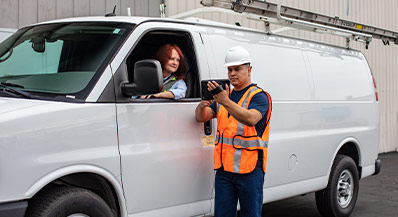Lytx Shares New Insights on Risky Driving Trends Among Construction Fleets

- Lytx construction clients experienced a 50% reduction in driver cell phone use from 2018 to 2019
- Drivers of construction vehicles were observed smoking behind the wheel more than drivers in any other industry
SAN DIEGO — April 28, 2020 — From its unmatched database of 192,000 risky driving events captured from construction fleets in 2019, Lytx® today released new insights into construction-industry driving trends.
Lytx’s findings include the five risky behaviors seen most often among construction drivers, the most improved driving behaviors, and insights on how construction-industry driving habits compare to those in other industries.
This data was captured from fleets of all sizes and types within the construction industry, including commercial and residential construction, contractors, builders, excavation, lumber, roofing fleets, and more. It is part of an ongoing series from Lytx highlighting key behavior trends seen across the nine industries that utilize Lytx video telematics technology. The data will be released twice weekly through May 19 here: https://www.lytx.com/en-us/industry-benchmark-data.
Most Prevalent Risky Behaviors in 2019
- Driver unbelted
- Late response*
- Smoking
- Other distraction**
- Food/drink observed
Most Improved Behaviors From 2018 to 2019
- Cell phone/device observed – improved 50%
- Incomplete stop – improved 20%
- Posted-speed violation – improved 27%
- Passenger unbelted – improved 12%
How Construction Fleets Stack Up Against Other Industries
Lytx compared the prevalence of behaviors seen in construction fleets against behavior averages of fleets across all its other protected industries. Comparatively, construction fleets stood out in the following areas:
- Posted-speed violation, which occurred 16% less often
- Smoking, which occurred 69% more often
- Other distraction,** which occurred 32% more often
Construction Collision Insight
Lytx also found that 91% of collisions in the construction segment were low impact. Late response,* one of the most prevalent behaviors in this space, contributed to 32% of low-impact rear-end collisions.
About the Data
These insights were derived from Lytx’s proprietary database of construction driving data from 2019, including 192,000 risky construction driving events captured last year. For comparisons across industries, Lytx calculated behavior averages from its global database, which contains driving data from trucking, distribution, concrete, utilities, services, transit, government, and waste industries. Lytx maintains the fastest-growing proprietary database of professional driving data in the world, currently surpassing 120 billion miles of driving data. The data is anonymized, normalized, and in instances of behavior prevalence, generalizable to construction fleets at large.
About Lytx
Lytx® is a leading provider of video telematics, analytics, safety, and productivity solutions for commercial, public sector, and field services fleets. Our unrivaled Driver Safety Program, powered by our best-in-class DriveCam® Event Recorder, is proven to help save lives and reduce risk. We harness the power of video to help clients see what happened in the past, manage their operations more efficiently in the present, and improve driver behavior to change the future. Our customizable services and programs span driver safety, risk detection, fleet tracking, compliance, and fuel management. Using the world’s largest driving database of its kind, along with proprietary machine vision and artificial intelligence technology, we help protect and connect thousands of fleets and more than 1.3 million drivers worldwide. For more information on Lytx telematics system, visit http://www.lytx.com, @lytx on Twitter, LinkedIn, our Facebook page, or our YouTube channel.
*Late response occurs when a driver is not distracted yet responds late and abruptly to a readily visible risky situation ahead.
**Other distraction occurs when a driver is distracted by something Lytx does not explicitly capture (i.e., cell phone, other device, food/drink, or passenger); examples include directing too much attention to other drivers or pedestrians, lighting a cigarette, or viewing paperwork.
# # #
